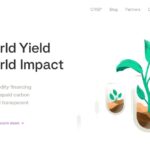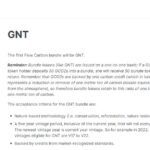Understanding Klima DAO’s nature
Our introduction to Klima DAO begins with understanding what a Decentralized Autonomous Organization (DAO) is. A DAO is an organization deployed as smart contracts on existing blockchains. It establishes governance rules, enabling members to vote for the organization’s future using their individual wallets. DAOs have specific goals, labor resources, and assets, mirroring cooperatives that operate remotely via online platforms. The degree of decentralization or anonymity varies among DAOs, with some adhering to a centralized system powered by smart contracts.
Klima DAO commenced its journey in October 2021, after raising 17 million dollars from PetRockcapital.
Organizational structure:
Core Team: This team directs the DAO’s decentralization strategy, ensuring alignment of various teams towards right priorities, efficient collaboration, and goal accomplishment.
Functional Stewards: These individuals interface with the Core Team to translate strategic visions into viable projects and work streams. They also coordinate with internal and external contributors for project execution, adhering to proposed budgets, timelines, and quality standards. Some Functional Stewards also form part of the Core Team.
Policy Team: This team is responsible for economic modeling and formulating monetary policy, including members from the Core and Council teams, and contributors from the Policy department.
Internal Contributors: They are full-fledged members of a DAO functional team, selected and integrated by a Functional Steward after a rigorous application process.
External Contributors:
- Bounty Contributors: Bounty Hunters who have previously completed bounties and are approved to work on specific functional teams. Recognized as valuable contributors, they enjoy greater access to internal DAO communications. However, their compensation is confined to the completion of published bounties as available.
- Third-Party Contractors: If necessary, the DAO might contract with third parties for specific services. For example, a PR agency.
Bounty Hunter: Every applicant aspiring to be a DAO contributor automatically becomes a Bounty Hunter. They have access to the internal DAO bounty board and are encouraged to contribute to minor projects, complete bounties without any guaranteed compensation until a department is equipped to engage them as a Bounty Contributor or Internal Contributor.
Token Holders: These stakeholders play a critical role in supporting the protocol’s growth and participating in the governance process through discussions and voting.
Partners: These are organizations that have established a relationship with KlimaDAO.

Governance process

Token holders take part in governance process remotely, using
Main carbon market challenges and Klima DAO goals
Major challenges in carbon markets, KlimaDAO is set to tackle:
- Illiquidity: The carbon credit market is characterized by an abundance of distinct types of credits. These come from varied projects located in different countries, produced over different years. Such diversity creates fragmentation and complexity, thereby disrupting the buying process and compromising overall market liquidity.
- Opacity: The often secretive nature of transactions results in an ambiguous pricing policy. This lack of transparency primarily benefits brokers, while creating obstacles for a fair and open market.
- Inefficiency: The acquisition and retirement of carbon credits is an intricate procedure teeming with hurdles. Buyers often need to connect with numerous brokers to gain insight into available credits, their pricing, and to access project development documentation. Moreover, buyers must create an account in the specific Registry of the carbon credits they intend to purchase. Each Registry, with its own account creation fees, annual charges, and transactional costs, adds another layer of complexity to the process.
KlimaDAO goals:
1: Increase the demand for carbon credit tokens;
2: Establish Klima as a Carbon-Backed Reserve Cryptocurrency;
3: Facilitate the Climate Markets
KlimaDAO mechanisms to increase the demand for carbon credit tokens
Bonding carbon credit tokens to the DAO treasury allowed individuals to acquire KLIMA at a discount. KLIMA and carbon credit tokens were distributed over a span of 5 days to prevent instant arbitrage trading. Klima DAO created new KLIMA tokens without any expense and received carbon credit tokens in return. Various carbon credit tokens such as BCT, UBO, NBO, and MCO2 were offered as bonding options. Currently, all bonds have been sold out
Staking involves holding KLIMA tokens in a wallet for a specified duration to garner rewards. This process enhances the liquidity of the DAO treasury, and in response, users are granted an equivalent quantity of sKLIMA in their wallets. Klima DAO incentivizes the staking of KLIMA by offering stakers a high APY, which previously reached 35K%. Currently, the annualized KLIMA reward stands at 20%
As a result of these initiatives, 25.4 million carbon credits were tokenized, with 584,000 of them retired. The most recent phase of tokenization took place in 2022.
Klima as a carbon-backed reserve cryptocurrency
As can be seen from the graph , the peak of the carbon credit tokenization process occurred in the autumn of 2022. Verified Carbon Standard (VCS) tokens were the primary source for tokenization . Concurrently, Verra declared that the tokenization of its carbon credits was illegal and in violation of the Registry’s terms of use. From that point onwards, the process of tokenization and retirement of carbon credits effectively came to a halt.

Klima DAO as climate market facilitator
After the tokenization ban from Verra, KlimaDAO shifted its focus towards two key processes:
- The creation of marketplaces for selling carbon credit tokens: Initially, Klima DAO launched an application designed for this purpose. Subsequently, in April 2023, it developed the CarbonMark marketplace.. The main commodity are already tokenized VCS carbon credits
- Buying futures of carbon credits. Appropriate case is buying future carbon credits from climate project Improved Cookstoves for Rohingya Refugees in Bangladesh
Conclusion:
Despite KlimaDAO demonstrated innovative model of investing in carbon market, it has not predict the reaction for activity on tokenization from the main players: carbon standard program and potential buyers. In fact from the moment of Verra statement all carbon tokens backed KLIMA lost their environmental value.









